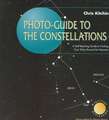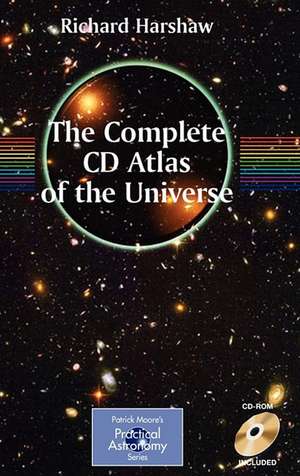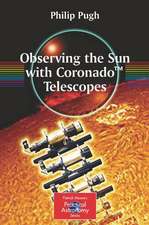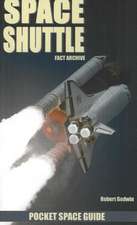The Complete CD Guide to the Universe: The Patrick Moore Practical Astronomy Series
Autor Richard Harshawen Limba Engleză Hardback – 13 apr 2007
| Toate formatele și edițiile | Preț | Express |
|---|---|---|
| Paperback (1) | 213.07 lei 38-44 zile | |
| Springer – 27 noi 2014 | 213.07 lei 38-44 zile | |
| Hardback (1) | 210.01 lei 3-5 săpt. | |
| Springer – 13 apr 2007 | 210.01 lei 3-5 săpt. |
Din seria The Patrick Moore Practical Astronomy Series
-
 Preț: 258.21 lei
Preț: 258.21 lei -
 Preț: 164.94 lei
Preț: 164.94 lei -
 Preț: 324.21 lei
Preț: 324.21 lei -
 Preț: 255.10 lei
Preț: 255.10 lei - 8%
 Preț: 581.98 lei
Preț: 581.98 lei -
 Preț: 159.16 lei
Preț: 159.16 lei -
 Preț: 282.38 lei
Preț: 282.38 lei -
 Preț: 308.55 lei
Preț: 308.55 lei -
 Preț: 309.87 lei
Preț: 309.87 lei -
 Preț: 332.98 lei
Preț: 332.98 lei -
 Preț: 276.91 lei
Preț: 276.91 lei -
 Preț: 243.94 lei
Preț: 243.94 lei -
 Preț: 183.40 lei
Preț: 183.40 lei -
 Preț: 378.09 lei
Preț: 378.09 lei -
 Preț: 302.20 lei
Preț: 302.20 lei -
 Preț: 212.68 lei
Preț: 212.68 lei -
 Preț: 271.39 lei
Preț: 271.39 lei -
 Preț: 252.91 lei
Preț: 252.91 lei -
 Preț: 281.95 lei
Preț: 281.95 lei -
 Preț: 289.85 lei
Preț: 289.85 lei -
 Preț: 218.84 lei
Preț: 218.84 lei -
 Preț: 282.38 lei
Preț: 282.38 lei -
 Preț: 128.86 lei
Preț: 128.86 lei -
 Preț: 301.10 lei
Preț: 301.10 lei -
 Preț: 204.78 lei
Preț: 204.78 lei -
 Preț: 307.44 lei
Preț: 307.44 lei -
 Preț: 303.07 lei
Preț: 303.07 lei -
 Preț: 258.83 lei
Preț: 258.83 lei -
 Preț: 155.25 lei
Preț: 155.25 lei -
 Preț: 193.97 lei
Preț: 193.97 lei -
 Preț: 208.26 lei
Preț: 208.26 lei -
 Preț: 279.09 lei
Preț: 279.09 lei -
 Preț: 303.51 lei
Preț: 303.51 lei -
 Preț: 277.54 lei
Preț: 277.54 lei -
 Preț: 208.51 lei
Preț: 208.51 lei -
 Preț: 214.86 lei
Preț: 214.86 lei -
 Preț: 304.58 lei
Preț: 304.58 lei -
 Preț: 220.57 lei
Preț: 220.57 lei -
 Preț: 157.32 lei
Preț: 157.32 lei -
 Preț: 275.98 lei
Preț: 275.98 lei -
 Preț: 288.98 lei
Preț: 288.98 lei -
 Preț: 261.49 lei
Preț: 261.49 lei -
 Preț: 279.09 lei
Preț: 279.09 lei -
 Preț: 160.82 lei
Preț: 160.82 lei -
 Preț: 327.01 lei
Preț: 327.01 lei -
 Preț: 254.90 lei
Preț: 254.90 lei -
 Preț: 304.38 lei
Preț: 304.38 lei -
 Preț: 256.84 lei
Preț: 256.84 lei
Preț: 210.01 lei
Nou
Puncte Express: 315
Preț estimativ în valută:
40.19€ • 41.80$ • 33.18£
40.19€ • 41.80$ • 33.18£
Carte disponibilă
Livrare economică 24 martie-07 aprilie
Preluare comenzi: 021 569.72.76
Specificații
ISBN-13: 9780387468938
ISBN-10: 0387468935
Pagini: 120
Ilustrații: XIV, 120 p.
Dimensiuni: 155 x 235 x 11 mm
Greutate: 0.37 kg
Ediția:2007
Editura: Springer
Colecția Springer
Seria The Patrick Moore Practical Astronomy Series
Locul publicării:New York, NY, United States
ISBN-10: 0387468935
Pagini: 120
Ilustrații: XIV, 120 p.
Dimensiuni: 155 x 235 x 11 mm
Greutate: 0.37 kg
Ediția:2007
Editura: Springer
Colecția Springer
Seria The Patrick Moore Practical Astronomy Series
Locul publicării:New York, NY, United States
Public țintă
Popular/generalCuprins
Book: Introduction.- How to observe different types of objects.- How to rate the sky.- How to keep a log.- How to observe double stars.- Detailed instructions on how to use the CD-R, with screen shots, examples, and a tutorial.- Appendix : summaries of the CD-R contents.CD-ROM: Approximately 3,000 pages (in PDF format) of maps and descriptive material, broken down as follows.- Double Stars.- Dark nebulae.- Bright nebulae.- Planetary nebulae.- Supernova remnants.- Open clusters.- Globular clusters.- Galaxies.- Quasi stellar objects.- Other.- Index.- Acrobat ® Reader.- Appendices.
Recenzii
From the reviews:
"Amateur astronomer Harshaw (Stardeck Observatory, MO) compiled this recent entry in the ‘Practical Astronomy’ series. …The CD-ROM is well organized; it includes bank observing forms and images of more than 10,000 double stars, more than 1,400 galaxies, and other objects reachable by an amateur-size telescope. … Charts are of excellent quality. … Summing Up: Recommended. General readers." (M. –K. Hemenway, CHOICE, Vol. v4 (3), November, 2007)
"The printed part of the book contains clear and simple explanations of some of the basics of amateur astronomical observing … . The heart of the work is the CD-ROM with finding charts and the listing of the 13,238 objects. …Overall, for those amateurs in the northern hemisphere of a taxonomic bent this CD atlas would be of great assistance." (Nick Lomb, Australian Physics, Vol. 44 (4), 2007)
"Patrick Moore in his book, ‘Atlas of the Universe’ brings many of the wonders of this space … . The universe is big but this book makes it all very manageable. … the book is a veritable treasure of information and pictures suitable for the young and uninitiated who want to learn more of the universe in which Earth travels. … With copious pictures and well rounded phrases, anyone can use this book to help them travel off-planet to wherever their eyes lead them." (Mark Mortimer, Universe Today, September, 2006)
"Amateur astronomer Harshaw (Stardeck Observatory, MO) compiled this recent entry in the ‘Practical Astronomy’ series. …The CD-ROM is well organized; it includes bank observing forms and images of more than 10,000 double stars, more than 1,400 galaxies, and other objects reachable by an amateur-size telescope. … Charts are of excellent quality. … Summing Up: Recommended. General readers." (M. –K. Hemenway, CHOICE, Vol. v4 (3), November, 2007)
"The printed part of the book contains clear and simple explanations of some of the basics of amateur astronomical observing … . The heart of the work is the CD-ROM with finding charts and the listing of the 13,238 objects. …Overall, for those amateurs in the northern hemisphere of a taxonomic bent this CD atlas would be of great assistance." (Nick Lomb, Australian Physics, Vol. 44 (4), 2007)
"Patrick Moore in his book, ‘Atlas of the Universe’ brings many of the wonders of this space … . The universe is big but this book makes it all very manageable. … the book is a veritable treasure of information and pictures suitable for the young and uninitiated who want to learn more of the universe in which Earth travels. … With copious pictures and well rounded phrases, anyone can use this book to help them travel off-planet to wherever their eyes lead them." (Mark Mortimer, Universe Today, September, 2006)
Notă biografică
Richard Harshaw lives in Kansas, where he works as a consultant. During his 40 years of practical observing, (seventeen of them with large-aperture instruments) he has received eight Astronomical League observing awards, and has published measurements of approximately 1,600 double stars.
His many published papers include Third Degree Views (The Webb Society’s Deep Sky Observer, No. 121, Summer 2000); Color in Double Stars (Deep Sky Observer, No. 116, April 1999); An Investigation Into Discrepancies In the Washington Double Star Catalog (Deep Sky Observer, No. 129); On Double Identities, Recovered Pairs, and Optical Imposters in the Washington Double Star Catalog (Webb Society Double Star Section Circular No. 12, 2004); New Measures for Some ‘Neglected’ Double Stars of the Washington Double Star Catalog (Double Star Section Circular No. 12, 2004); Possible Quadrant Reversals in the WDS Catalog 2001.0 (Double Star Section Circular No. 11, 2003).
His many published papers include Third Degree Views (The Webb Society’s Deep Sky Observer, No. 121, Summer 2000); Color in Double Stars (Deep Sky Observer, No. 116, April 1999); An Investigation Into Discrepancies In the Washington Double Star Catalog (Deep Sky Observer, No. 129); On Double Identities, Recovered Pairs, and Optical Imposters in the Washington Double Star Catalog (Webb Society Double Star Section Circular No. 12, 2004); New Measures for Some ‘Neglected’ Double Stars of the Washington Double Star Catalog (Double Star Section Circular No. 12, 2004); Possible Quadrant Reversals in the WDS Catalog 2001.0 (Double Star Section Circular No. 11, 2003).
Textul de pe ultima copertă
This guide contains descriptions and charts for a total of almost 14,000 objects, and is probably the largest and most comprehensive Atlas of the Universe ever created for amateur astronomers.
Spanning some 13,000 pages, this is a project that is possible only with Springer Extras.
The atlas covers the whole range of objects viewable by amateur astronomers with 8 - to 11-inch telescopes, north of about latitude +40 degrees. Everything described here can be observed from suburban sites. Large-scale finder charts - in both normal and mirror-image "SCT" views - along with the extensive list of 14,000 objects provide a detailed observing guide for almost any practical amateur astronomer.
Around 10,750 of the objects are double or multiple stars; the remaining 3000 or so represent the other classes of deep-sky objects. Double stars dominate this work for two reasons. First, for telescopes of modest aperture they are by far the most numerous type of object and second, double stars are usually bright enough to be easily observed from urban sites. The other deep-sky objects include many galaxies (1573 of them), and although dark-sky sites are of course best, many of these can be seen in skies that most amateurs would write off as hopeless for the task. There are 580 open clusters, 109 globular clusters, 148 planetary nebulae, plus a few others.
The Complete CD Atlas of the Universe is a resource that could easily provide the basis of a whole lifetime of observing!
Spanning some 13,000 pages, this is a project that is possible only with Springer Extras.
The atlas covers the whole range of objects viewable by amateur astronomers with 8 - to 11-inch telescopes, north of about latitude +40 degrees. Everything described here can be observed from suburban sites. Large-scale finder charts - in both normal and mirror-image "SCT" views - along with the extensive list of 14,000 objects provide a detailed observing guide for almost any practical amateur astronomer.
Around 10,750 of the objects are double or multiple stars; the remaining 3000 or so represent the other classes of deep-sky objects. Double stars dominate this work for two reasons. First, for telescopes of modest aperture they are by far the most numerous type of object and second, double stars are usually bright enough to be easily observed from urban sites. The other deep-sky objects include many galaxies (1573 of them), and although dark-sky sites are of course best, many of these can be seen in skies that most amateurs would write off as hopeless for the task. There are 580 open clusters, 109 globular clusters, 148 planetary nebulae, plus a few others.
The Complete CD Atlas of the Universe is a resource that could easily provide the basis of a whole lifetime of observing!
Caracteristici
Large-scale and very detailed finder charts for every part of the sky, from –40° declination to the North Celestial Pole in both normal and mirror image views, let the observer find things just as they appear in his telescope Extensive catalog of 14,000 objects, including double stars, nebulae, planetary nebulae, open clusters, globular clusters, galaxies, etc. Plenty to observe for years and years Detailed descriptions of the author’s observations of hundreds of objects, and observing reports from various amateurs are included. Readers can have confidence that these objects really have been observed with an amateur telescope instrument of 8 inches or larger Extensive historical data on important objects in the catalog. Helps build an understanding of the development of modern astronomy and man’s awareness of the vastness of the cosmos Extensive double star measurement histories are included for most of the double stars. This helps show when pairs are in rapid displacement so the observer can be ready to adjust for separations and position angles







